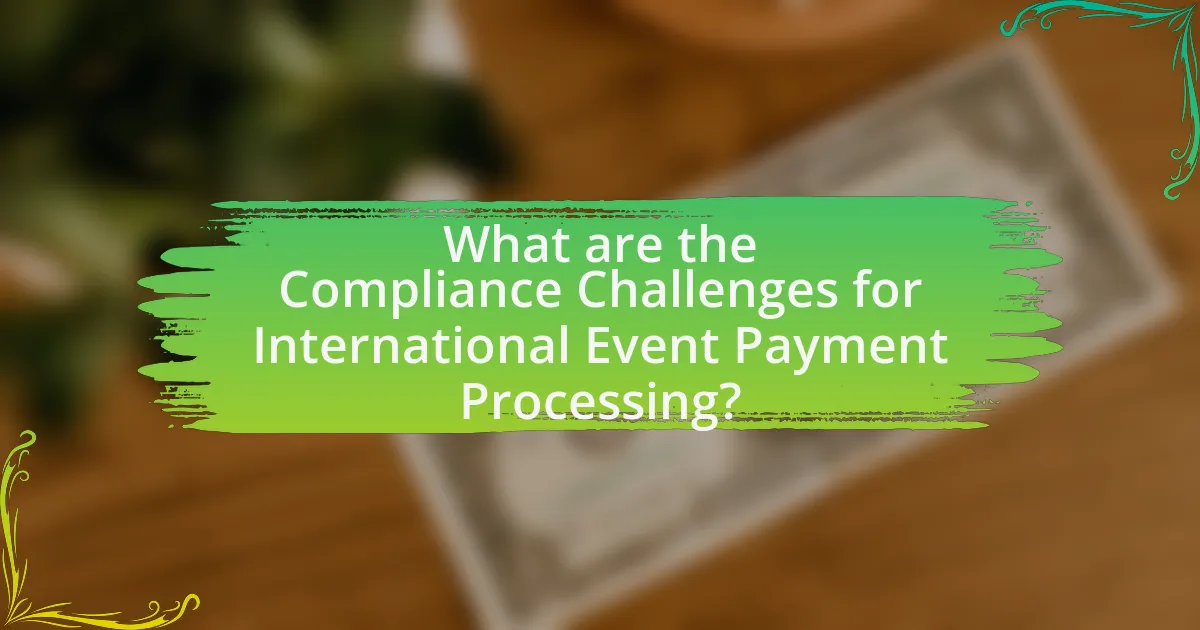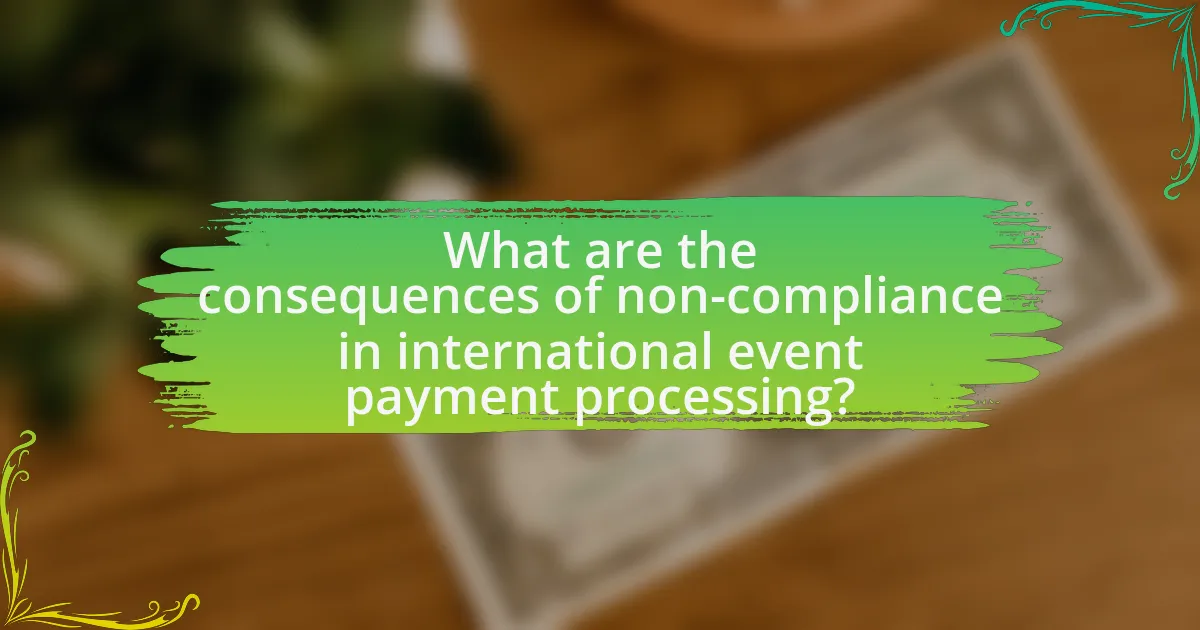The article focuses on the compliance challenges faced by organizations involved in international event payment processing. It highlights the complexities of navigating diverse regulatory frameworks, managing currency exchange risks, and adhering to anti-money laundering (AML) and know your customer (KYC) requirements. Key topics include the importance of compliance, the varying regulations across countries, common challenges organizations encounter, and the implications of non-compliance, such as financial penalties and reputational damage. Additionally, the article discusses the role of technology in enhancing compliance efforts and best practices organizations can adopt to mitigate compliance risks effectively.
What are the Compliance Challenges for International Event Payment Processing?

Compliance challenges for international event payment processing include navigating diverse regulatory frameworks, managing currency exchange risks, and ensuring adherence to anti-money laundering (AML) and know your customer (KYC) requirements. Different countries have varying laws regarding payment processing, which can complicate transactions and increase the risk of non-compliance. For instance, the European Union’s PSD2 directive mandates strong customer authentication, while the United States has different regulations that may not align. Additionally, currency fluctuations can impact transaction values, leading to potential financial losses. Compliance with AML and KYC regulations is critical, as failure to verify customer identities can result in severe penalties and legal repercussions. These factors collectively create a complex landscape for organizations involved in international event payment processing.
Why is compliance important in international event payment processing?
Compliance is crucial in international event payment processing because it ensures adherence to legal and regulatory standards across different jurisdictions. This adherence mitigates risks such as fraud, money laundering, and data breaches, which can lead to significant financial penalties and reputational damage. For instance, the Financial Action Task Force (FATF) sets international standards that require compliance with anti-money laundering (AML) regulations, which are essential for maintaining the integrity of financial transactions. Non-compliance can result in fines that may reach millions of dollars, as seen in cases involving major corporations that failed to meet these standards. Therefore, compliance not only protects organizations from legal repercussions but also fosters trust among stakeholders and participants in international events.
What regulations govern international payment processing?
International payment processing is governed by a combination of regulations including the Payment Services Directive (PSD2) in the European Union, the Bank Secrecy Act (BSA) in the United States, and the Anti-Money Laundering (AML) regulations globally. These regulations establish requirements for financial institutions and payment service providers to ensure secure transactions, prevent fraud, and combat money laundering. For instance, PSD2 mandates strong customer authentication and transparency in fees, while the BSA requires reporting of suspicious activities to prevent illicit financial flows. Compliance with these regulations is essential for facilitating safe and efficient international transactions.
How do compliance requirements vary by country?
Compliance requirements vary significantly by country due to differing legal frameworks, regulatory bodies, and cultural norms. For instance, the European Union mandates strict data protection regulations under the General Data Protection Regulation (GDPR), while the United States has a more fragmented approach with various state-level laws like the California Consumer Privacy Act (CCPA). Additionally, countries like China enforce stringent cybersecurity laws that require data localization, contrasting with more lenient regulations in nations such as Singapore, which promotes a business-friendly environment. These variations necessitate that organizations engaged in international event payment processing adapt their compliance strategies to align with local laws and regulations, ensuring legal adherence and minimizing risks.
What are the common compliance challenges faced by organizations?
Organizations commonly face challenges such as regulatory complexity, data privacy issues, and varying compliance standards across jurisdictions. Regulatory complexity arises from the need to navigate multiple laws and regulations, which can differ significantly between countries, making it difficult for organizations to ensure compliance. Data privacy issues are prevalent due to stringent regulations like the General Data Protection Regulation (GDPR) in Europe, requiring organizations to implement robust data protection measures. Additionally, varying compliance standards can lead to inconsistencies in how organizations operate internationally, as they must adapt to local laws while maintaining global operational efficiency. These challenges can result in legal penalties, financial losses, and reputational damage if not managed effectively.
How do currency exchange regulations impact compliance?
Currency exchange regulations significantly impact compliance by establishing legal frameworks that dictate how financial transactions involving different currencies must be conducted. These regulations require organizations to adhere to specific reporting standards, anti-money laundering (AML) measures, and know-your-customer (KYC) protocols, which are essential for maintaining transparency and preventing illicit activities. For instance, the Financial Action Task Force (FATF) guidelines necessitate that businesses involved in currency exchange monitor transactions and report suspicious activities, thereby increasing the compliance burden. Non-compliance can lead to severe penalties, including fines and restrictions on operations, highlighting the critical role of these regulations in shaping compliance strategies for organizations engaged in international payment processing.
What role do anti-money laundering (AML) laws play in compliance challenges?
Anti-money laundering (AML) laws create significant compliance challenges for organizations involved in international event payment processing by imposing stringent regulatory requirements that must be met to prevent financial crimes. These laws require entities to implement robust systems for monitoring transactions, conducting customer due diligence, and reporting suspicious activities, which can be resource-intensive and complex. For instance, the Financial Action Task Force (FATF) sets international standards that necessitate compliance with AML regulations, leading to increased operational costs and the need for specialized training. Failure to comply can result in severe penalties, including fines and reputational damage, further complicating the compliance landscape for businesses operating across borders.
How do technological advancements affect compliance in payment processing?
Technological advancements enhance compliance in payment processing by automating regulatory checks and improving data security. Automation tools, such as machine learning algorithms, enable real-time monitoring of transactions for suspicious activities, thereby ensuring adherence to anti-money laundering (AML) regulations. Additionally, advancements in encryption and tokenization protect sensitive customer data, aligning with data protection laws like the General Data Protection Regulation (GDPR). According to a report by the International Monetary Fund, the integration of advanced technologies in payment systems has led to a 30% reduction in compliance-related costs for financial institutions, demonstrating the effectiveness of these innovations in maintaining compliance.
What are the implications of using blockchain technology for compliance?
The implications of using blockchain technology for compliance include enhanced transparency, improved traceability, and increased efficiency in regulatory reporting. Blockchain’s decentralized ledger allows for real-time access to transaction data, which can simplify audits and ensure adherence to compliance standards. For instance, a study by the World Economic Forum highlights that blockchain can reduce compliance costs by up to 30% by automating processes and minimizing human error. Additionally, the immutable nature of blockchain records ensures that data cannot be altered, providing a reliable audit trail that regulators can trust.
How can artificial intelligence assist in meeting compliance requirements?
Artificial intelligence can assist in meeting compliance requirements by automating data analysis and monitoring processes. AI technologies, such as machine learning algorithms, can analyze vast amounts of transaction data in real-time to identify patterns and anomalies that may indicate non-compliance with regulations. For instance, AI can help organizations adhere to anti-money laundering (AML) regulations by flagging suspicious transactions based on predefined criteria, thus reducing the risk of human error. Additionally, AI can streamline the documentation process by automatically generating compliance reports, ensuring that all necessary information is accurately captured and submitted on time. This capability not only enhances efficiency but also supports organizations in maintaining compliance with evolving regulatory standards.
What are the consequences of non-compliance in international event payment processing?

Non-compliance in international event payment processing can lead to severe financial penalties and legal repercussions. Organizations may face fines imposed by regulatory bodies, which can range from thousands to millions of dollars depending on the severity of the violation. Additionally, non-compliance can result in the freezing of accounts or the suspension of payment processing services, disrupting cash flow and operational capabilities.
Moreover, reputational damage is a significant consequence, as stakeholders may lose trust in an organization that fails to adhere to compliance standards. This can lead to a loss of business opportunities and partnerships, as clients and vendors prefer to engage with compliant entities.
Furthermore, non-compliance can expose organizations to increased scrutiny from regulators, leading to more frequent audits and oversight, which can strain resources and divert attention from core business activities. In summary, the consequences of non-compliance in international event payment processing encompass financial penalties, operational disruptions, reputational harm, and heightened regulatory scrutiny.
What legal penalties can organizations face for non-compliance?
Organizations can face significant legal penalties for non-compliance, including fines, sanctions, and legal action. For instance, under the General Data Protection Regulation (GDPR), organizations can incur fines up to 4% of their annual global revenue or €20 million, whichever is higher, for failing to comply with data protection requirements. Additionally, non-compliance with financial regulations can lead to penalties imposed by regulatory bodies, which may include hefty fines and restrictions on business operations. These penalties serve as a deterrent and emphasize the importance of adhering to compliance standards in international event payment processing.
How can non-compliance affect an organization’s reputation?
Non-compliance can severely damage an organization’s reputation by eroding trust among stakeholders, including customers, partners, and regulators. When an organization fails to adhere to legal and regulatory standards, it risks public scrutiny and negative media coverage, which can lead to a loss of credibility. For instance, a study by the Ponemon Institute found that 67% of consumers would stop purchasing from a company that experienced a data breach due to non-compliance with data protection regulations. This illustrates that non-compliance not only affects immediate financial performance but also long-term brand loyalty and market position.
What financial risks are associated with non-compliance?
Non-compliance with financial regulations poses significant financial risks, including hefty fines, legal penalties, and loss of business licenses. For instance, companies that fail to adhere to anti-money laundering laws can face fines that reach millions of dollars, as seen in cases like the $1.1 billion penalty imposed on Deutsche Bank in 2017 for compliance failures. Additionally, non-compliance can lead to increased scrutiny from regulatory bodies, resulting in costly audits and operational disruptions. Ultimately, these financial repercussions can severely impact a company’s profitability and market reputation.
How does non-compliance impact customer trust and satisfaction?
Non-compliance significantly undermines customer trust and satisfaction by creating perceptions of unreliability and risk. When organizations fail to adhere to regulations, customers may feel their personal and financial information is not secure, leading to decreased confidence in the brand. A study by PwC found that 55% of consumers would stop purchasing from a company that does not comply with regulations, highlighting the direct correlation between compliance and customer loyalty. Furthermore, non-compliance can result in negative publicity and legal repercussions, further eroding customer satisfaction and trust in the long term.
What are the long-term effects of losing customer trust due to compliance issues?
Losing customer trust due to compliance issues leads to significant long-term effects, including decreased customer loyalty, reduced revenue, and lasting damage to brand reputation. When customers perceive a company as non-compliant, they are likely to seek alternatives, resulting in a decline in repeat business. According to a 2020 study by PwC, 59% of consumers would stop buying from a brand they no longer trust, highlighting the direct correlation between trust and customer retention. Additionally, companies may face increased scrutiny from regulators and potential legal repercussions, further complicating their operational landscape. This erosion of trust can take years to rebuild, as evidenced by the long recovery periods experienced by companies involved in high-profile compliance scandals, such as Volkswagen and Wells Fargo.
How can organizations rebuild trust after a compliance failure?
Organizations can rebuild trust after a compliance failure by implementing transparent communication and corrective actions. Transparency involves openly acknowledging the compliance failure, detailing its causes, and outlining steps taken to prevent recurrence. For instance, a study by the Ethics & Compliance Initiative found that organizations that communicate effectively during crises can restore stakeholder confidence more rapidly. Additionally, organizations should engage in regular compliance training and audits to reinforce a culture of accountability and adherence to regulations. This proactive approach not only demonstrates commitment to compliance but also fosters a sense of security among stakeholders, ultimately aiding in the restoration of trust.
What best practices can organizations adopt to ensure compliance in international event payment processing?
Organizations can adopt several best practices to ensure compliance in international event payment processing, including implementing robust Know Your Customer (KYC) procedures, utilizing secure payment gateways, and staying updated with local regulations. KYC procedures help organizations verify the identity of participants, reducing the risk of fraud and ensuring adherence to anti-money laundering laws. Secure payment gateways protect sensitive financial information, minimizing the risk of data breaches and ensuring compliance with data protection regulations such as the General Data Protection Regulation (GDPR). Additionally, organizations should regularly review and update their compliance policies to align with changing international laws and regulations, as non-compliance can lead to significant financial penalties and reputational damage.
How can organizations stay updated on compliance regulations?
Organizations can stay updated on compliance regulations by implementing a systematic approach that includes subscribing to regulatory updates, attending industry conferences, and utilizing compliance management software. Subscribing to newsletters from regulatory bodies and industry associations provides timely information on changes in laws and regulations. Attending conferences allows organizations to network with experts and gain insights into emerging compliance trends. Additionally, compliance management software can automate the tracking of regulatory changes, ensuring that organizations remain informed and can adapt their practices accordingly. This multi-faceted strategy is essential for maintaining compliance in a rapidly evolving regulatory landscape.
What resources are available for tracking international payment regulations?
Resources for tracking international payment regulations include government websites, financial regulatory bodies, and specialized compliance platforms. Government websites, such as those of the Financial Action Task Force (FATF) and the International Monetary Fund (IMF), provide guidelines and updates on regulations. Financial regulatory bodies, like the European Banking Authority (EBA) and the U.S. Financial Crimes Enforcement Network (FinCEN), publish reports and regulatory changes. Additionally, compliance platforms such as LexisNexis Risk Solutions and ComplyAdvantage offer tools and databases that aggregate regulatory information, ensuring businesses stay informed about the latest requirements. These resources are essential for navigating the complex landscape of international payment regulations effectively.
How can organizations implement a compliance training program for employees?
Organizations can implement a compliance training program for employees by developing a structured curriculum that addresses relevant regulations and company policies. This involves assessing the specific compliance needs of the organization, creating engaging training materials, and utilizing various delivery methods such as online courses, workshops, and seminars. Regular assessments and feedback mechanisms should be established to evaluate employee understanding and retention of compliance information. Additionally, organizations should ensure that training is updated regularly to reflect changes in laws and regulations, thereby maintaining compliance and reducing risk.
What role does technology play in enhancing compliance efforts?
Technology plays a crucial role in enhancing compliance efforts by automating processes, improving data accuracy, and facilitating real-time monitoring. Automation reduces human error and increases efficiency in compliance tasks, such as data collection and reporting. For instance, regulatory technology (RegTech) solutions enable organizations to streamline compliance workflows, ensuring adherence to regulations like the General Data Protection Regulation (GDPR) and Anti-Money Laundering (AML) laws. Furthermore, advanced analytics and machine learning algorithms can analyze vast amounts of data to identify potential compliance risks, allowing organizations to proactively address issues before they escalate. According to a report by Deloitte, 60% of organizations using technology for compliance reported improved efficiency and reduced costs, demonstrating the tangible benefits of integrating technology into compliance strategies.
How can payment processing platforms ensure compliance automatically?
Payment processing platforms can ensure compliance automatically by integrating advanced compliance management systems that utilize real-time data analytics and machine learning algorithms. These systems continuously monitor transactions for adherence to regulatory requirements, such as anti-money laundering (AML) and know your customer (KYC) regulations. For instance, platforms can automatically verify customer identities and assess transaction risks using automated workflows, which reduces human error and enhances efficiency. Additionally, compliance software can be updated in real-time to reflect changes in laws and regulations, ensuring that payment processing remains aligned with the latest legal standards. This approach not only streamlines compliance efforts but also minimizes the risk of penalties associated with non-compliance.
What are the benefits of using compliance management software?
The benefits of using compliance management software include enhanced regulatory adherence, streamlined processes, and improved risk management. Compliance management software automates the tracking of regulations and standards, ensuring organizations remain up-to-date with legal requirements, which reduces the risk of non-compliance penalties. Additionally, it centralizes documentation and reporting, making it easier for teams to manage compliance tasks efficiently. According to a study by the International Compliance Association, organizations that implement compliance management software can reduce compliance costs by up to 30% while improving audit readiness and response times.
What practical steps can organizations take to mitigate compliance risks?
Organizations can mitigate compliance risks by implementing a robust compliance management system that includes regular audits, employee training, and clear policies. Regular audits help identify potential compliance gaps, while employee training ensures that staff are aware of compliance requirements and best practices. Clear policies provide a framework for compliance and establish accountability within the organization. According to a study by the Association of Certified Fraud Examiners, organizations with strong compliance programs can reduce the risk of fraud and regulatory violations by up to 50%.
How can regular audits help in maintaining compliance?
Regular audits help in maintaining compliance by systematically evaluating an organization’s adherence to regulatory standards and internal policies. These audits identify gaps in compliance, allowing organizations to address issues proactively before they escalate into significant violations. For instance, a study by the Institute of Internal Auditors found that organizations with regular audits are 50% more likely to detect compliance issues early, thereby reducing the risk of penalties and enhancing overall operational integrity.
What strategies can organizations employ to manage cross-border payment risks?
Organizations can manage cross-border payment risks by implementing robust compliance frameworks, utilizing advanced technology for transaction monitoring, and establishing strong partnerships with local financial institutions. A comprehensive compliance framework ensures adherence to international regulations, reducing the risk of penalties and fraud. Advanced technology, such as artificial intelligence and machine learning, enhances transaction monitoring by identifying suspicious activities in real-time, which is crucial given that the global cross-border payment market was valued at approximately $150 trillion in 2021, highlighting the scale of potential risks. Additionally, partnerships with local banks can provide insights into regional regulations and practices, further mitigating risks associated with currency fluctuations and regulatory changes.






